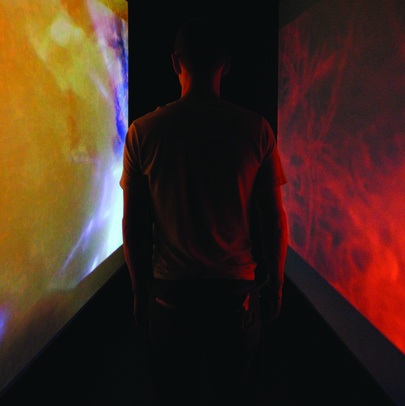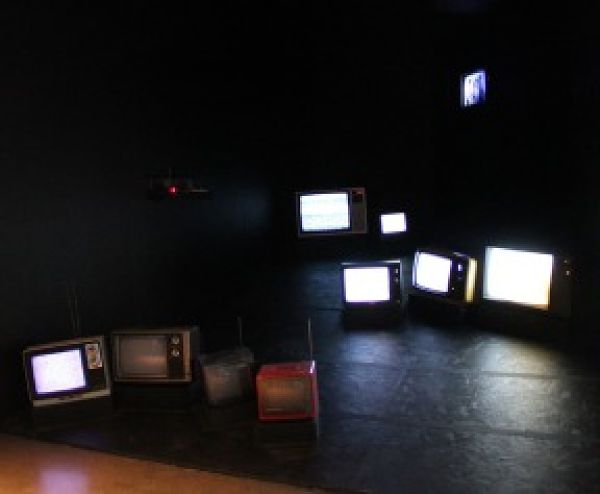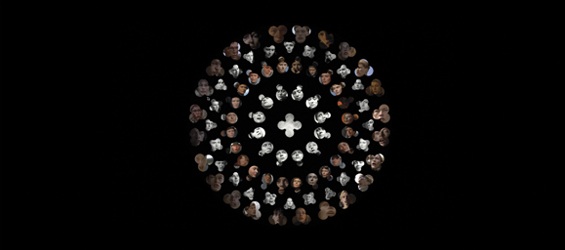MUSEUM OF CONTEMPORARY CANADIAN ART
February 4 – April 1, 2012
Tasman Richardson is a video and multi-media artist based in Toronto. He has exhibited and performed his work all over the world including Europe, Africa and Asia. Richardson’s artwork focuses on entropy, tele-presence, appropriation and JAW editing (which he founded), often using grim imagery. JAW editing consists of video cut ups used to create a possible narrative.
 Tasman Richardson, Memorial, Necropolis installation excerpt, 2011. Courtesy of the artist © Tasman Richardson.
Tasman Richardson, Memorial, Necropolis installation excerpt, 2011. Courtesy of the artist © Tasman Richardson.
The title of the exhibition itself, Necropolis, is a Greek term referring to a large cemetery or historic burial ground. This title seems ironic because Richardson’s multi-media exhibition involves bright colour, sound and the human ability to use his/her sight, perception, and touch in order to navigate through this shadowy trail. Once inside the gallery, the attendant will advise each viewer to proceed with absolute caution as it is dark, and those who are epileptic are not permitted to enter. Following this warning from the gallery attendant, the curious yet apprehensive spectator wanders into the blackened space, illuminated by a series of eerie video installations. The first work to be seen involves a slow and steady climb through numerous television sets. This installation piece named Forever Endeavor involves two separate screens facing each other, one depicting the late child actress Heather O’Rourke from the film Poltergeist, while the second screen illuminates the face of actress Naomi Watts from the film The Ring. These two actresses are frozen amongst evil scenes within their horror movies. Although these films were created twenty years apart, each of the females are haunted and victimized by ghosts through television. Being familiar with both these chilling films, as a spectator I begin to feel a subtle sense of panic.
 Tasman Richardson,Forever Endeavor, 2011. Necropolis installation excerpt, 2011. Courtesy of the artist © Tasman Richardson
Tasman Richardson,Forever Endeavor, 2011. Necropolis installation excerpt, 2011. Courtesy of the artist © Tasman Richardson
At this point the exhibition becomes severely dark and one must step over what seems to be a glass walkway sitting atop what looks like a sheer twenty-foot drop. This sense of panic now intensifies as the viewer realizes he/she must step over this glass plank. In order to successfully navigate through this black tunnel viewers must use their sense of touch by grazing and stumbling into walls. Finding one’s way around Necropolis is as confusing as it is frustrating, as you will begin to question the very basic details of perception, feeling lost at many times in Richardson’s dark passageway. Within this passageway Richardson’s work titled Parsec propels coloured light shooting out on both sides of the spectator, creating a visual play on colour and space perception. Following Richardson’s Parsec piece is his Memorial installation a marker in which one is nearing the end of this exhibition. This work consists of a circular Rose Window, similar to the one housed in Notre Dame’s cathedral. Within this Rose Window are small scenes of the remaking of Joan of Arc, consisting of head and shoulder video portraits of men and women. The faces of these men and women turn away from the dire fire located in the middle of the window. These faces act as personifications of Joan of Arc, who was famously burned to death as a culture of people became convinced she was an evil witch.
Tasman Richardson, Memorial, 2011. Necropolis installation excerpt, 2011. Courtesy of the artist © Tasman Richardson
With much of the exhibition I was more concerned with navigating through the dark passageways than focusing on each individual installation piece. Many of the pieces with the exception of Forever Endeavor and Memorial were difficult to connect with on a conceptual level. Forever Endeavor and Memorial had obvious conceptual parallels dealing with notions around evil spirits, humanity, and mass culture manipulation, whereas other works did not suggest this as obviously.
The most effective aspect of this exhibition is Richardson’s approach in allowing one to use their perception and senses. In order to navigate through the exhibition one is often getting lost in corners amidst the darkness. However, the blackened architectural layout of the exhibition facilitates frustration, subtle panic and anxiety amongst its viewers, loosing their appreciation for the complex and visually playful installations. It seems when viewing this exhibition people’s priority lies within one’s ability to navigate through the exhibition than deconstructing the work of art.
By: Amanda Pignotti

